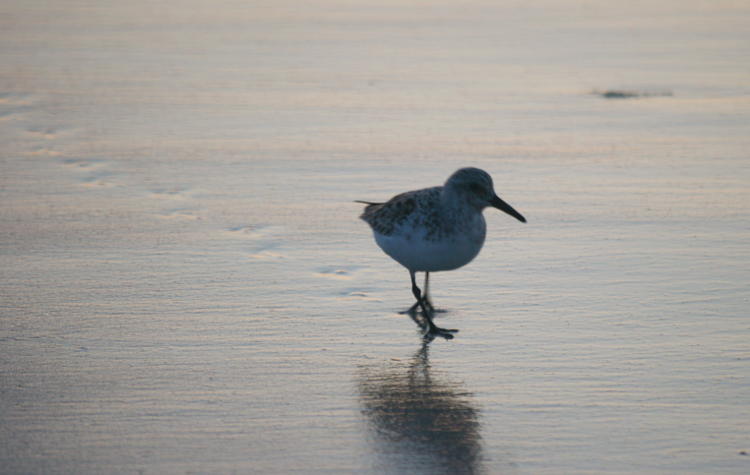
And so I finally get back to more of the beach trip, but part of the reason for the delay may soon become apparent, especially if you look at the page load times or sizes of some of the images. As I said, fewer pics this time around, largely because I was doing other vacationy things like abusing my muscles and joints, but there still remains plenty to put into this post.
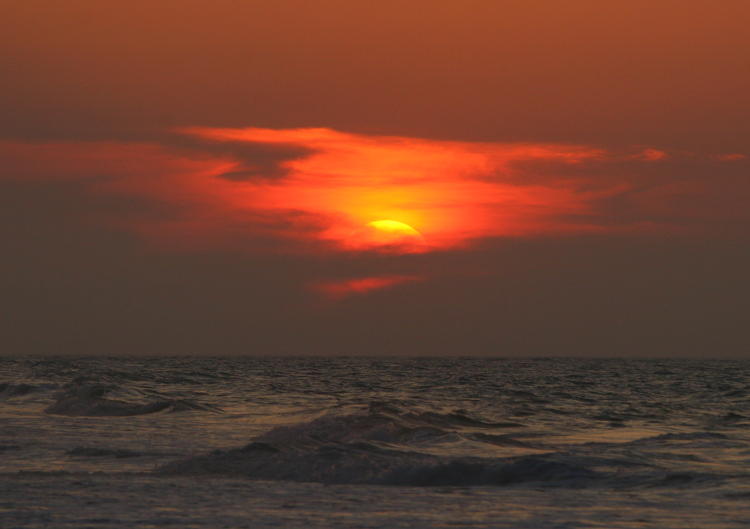
I was out most mornings for sunrise, but this time around conditions were a lot less cooperative – much more humidity and even some threatening storms, so no shot at the green flash this year (so far, anyway,) and some of the sunrises were just ehhhh. And for a couple of days, that’s almost the only thing I had the camera out for. The opening image was on one such morning, as a sanderling (Calidris alba) wandered along the waterline – I liked how the sand shows some delicate reflections from the sky. In most cases I was purposefully under-exposing a little to bring out sky colors better, but there are too many photos where the exposures seem much lower than that – not sure if this was a camera issue or what, since I didn’t notice it until I got back and unloaded, and most of my shots since then have been on full manual (macro style.) Gotta run some tests, I think.
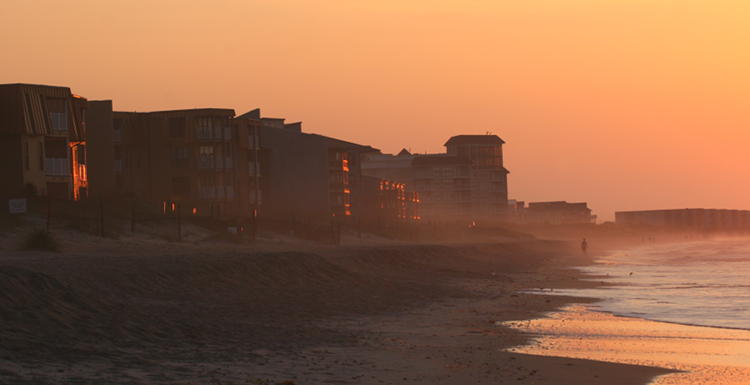
If you were to judge from this photo, you might think the area is over-developed, and it’s certainly more developed than large stretches of the Outer Banks further north, but in this area it’s a single row of mostly rental properties between the main dune and the quiet road up the strand, and at that time of year at least still pretty quiet – things might have changed a little since Memorial Day, the official start of summery things in the US. But even now, I imagine it’s not very crowded or noisy, and during sunrises I generally encountered maybe a half-dozen early risers on the beach, and the same number hanging out on balconies overlooking the surf. Definitely quieter than even around here, and we’re in a pretty mellow area.
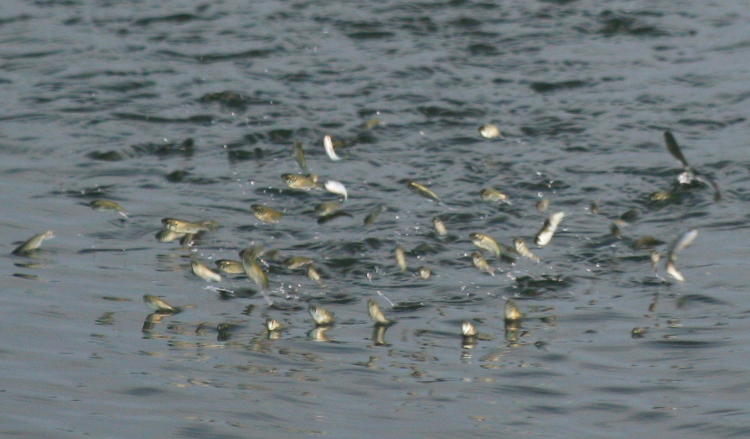
Last year I watched, and even successfully photographed, some species of fish that routinely leapt from the water three times, each time, which we saw again this year but a lot less of. More often, we’d see schools of minnows that were feeding (or perhaps even drinking) near the surface, and every minute or two something would make them spring from the water as an entire school at once – with several attempts, I finally snagged a frame, more challenging than it might seem since, even with autofocus, the lens couldn’t lock onto the smooth water when they weren’t leaping, and of course the school was meandering back and forth and had to be followed carefully to even have the momentary event within the frame.
One evening, we wandered down to the dock and gazebo, and by headlamps witnessed a very large number of what we took to be small shrimp hurtling at high speeds through the water, back and forth, and attracting opportunistic blue crabs. Lowering myself from the dock and trying several times, I managed to get one into my hand, only to discover that they weren’t shrimp, but annelids, one of which can be seen here. Definitely a creepy thing to suddenly see thrashing in your palm, even if it was less than 20mm in length and completely harmless to humans (I think, anyway. They might transmit Unacceptable Delaying Disease, but then again I think I had that before the beach trip.)
But all that’s pretty trivial compared to the next topic of this post, which is… crabs!
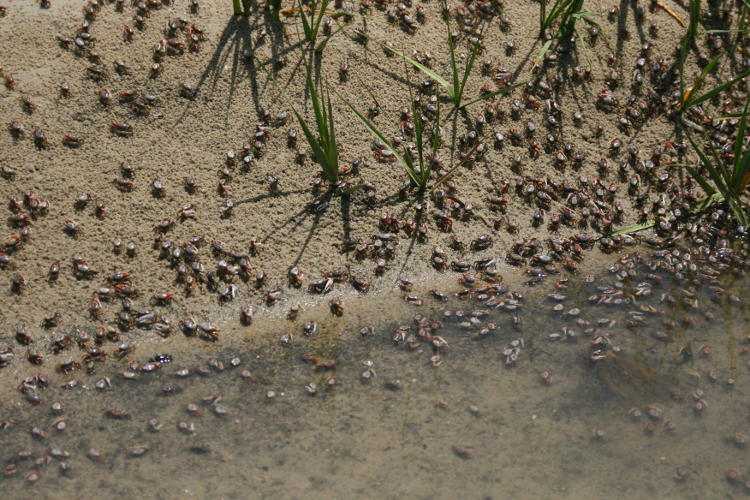
We went down to the south end of the island again this year, and got our timing right, arriving as the tide was transitioning from high to low (on a side note along that line, I downloaded an app to tell local tide times, which was quite handy while we were there but considerably less so now, where the closest visible tidal change is still 200 kilometers away.) Like last year, the Atlantic sand fiddler crabs (Uca pugilator) were swarming across the thin gully that allowed seawater to sweep inland during high tide, but ran dry as the tide went out, leaving behind whatever it is that this species eats. The still-damp regions of sand were absolutely covered with the little balls of sand left behind by their feeding method, and you could actually hear a chorus of little clicks from the masses of them. In one shallow pool, a blob of… something… was attracting the attention of several foragers.
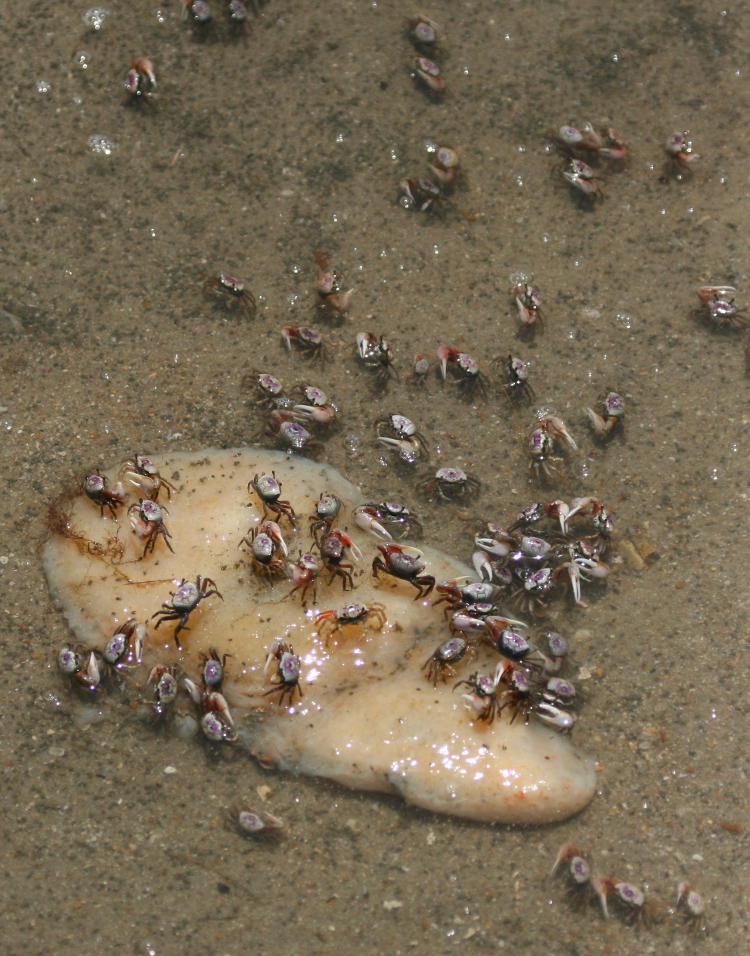
 One of our friends got the photo at left, which is as good a way as any to show scale (that’s a flip-flop,) but it perhaps gives the wrong impression of their aggressiveness, which is nonexistent. Happening upon the horde of crabs stretching across the sand, one can walk among them, where they will move aside politely but not in any apparently fearful way, and while they avoid contact, it doesn’t take much effort to capture one and hold it in cupped hands, where the most it will do is try to escape. You might imagine that the region was inundated with escape burrows, but very few were to be found – I suspect most of them were concealed in the dune grasses not too far away, but the handful of burrows to be seen were way out of proportion to the thousands of crabs coating the area.
One of our friends got the photo at left, which is as good a way as any to show scale (that’s a flip-flop,) but it perhaps gives the wrong impression of their aggressiveness, which is nonexistent. Happening upon the horde of crabs stretching across the sand, one can walk among them, where they will move aside politely but not in any apparently fearful way, and while they avoid contact, it doesn’t take much effort to capture one and hold it in cupped hands, where the most it will do is try to escape. You might imagine that the region was inundated with escape burrows, but very few were to be found – I suspect most of them were concealed in the dune grasses not too far away, but the handful of burrows to be seen were way out of proportion to the thousands of crabs coating the area.
I have to include another shot from our friend.
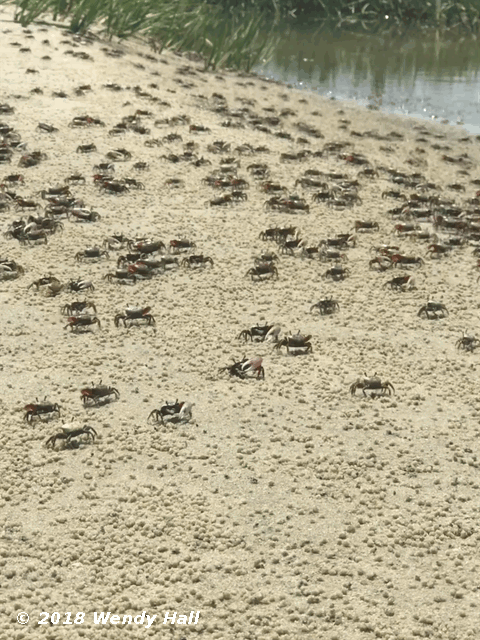 This was an animated gif (pronounced l’chaim) produced by her silly ass Apple phone, one of the plethora of options intended for social media or whatnot – I have to point out that the original file, while the same dimensions, was huge, looping 58 frames in a completely unnecessary manner – I removed two-thirds of the frames and lengthened the delay between, and you’d be hard put to see any difference, but I guess it’s important to slam your phone memory full with more detail than needed (do you get the impression that I’m picking on Apple? Dog forbid!)
This was an animated gif (pronounced l’chaim) produced by her silly ass Apple phone, one of the plethora of options intended for social media or whatnot – I have to point out that the original file, while the same dimensions, was huge, looping 58 frames in a completely unnecessary manner – I removed two-thirds of the frames and lengthened the delay between, and you’d be hard put to see any difference, but I guess it’s important to slam your phone memory full with more detail than needed (do you get the impression that I’m picking on Apple? Dog forbid!)
Yet what it does show is their feeding actions, if you look closer at the stationary ones anyway – you can see the smaller of their chelae (pincers) shoveling sand into their mouths, and the little sand pellets left behind. While you might be inclined to think the larger chelae were for defense, it doesn’t appear that they’re used in this manner much at all, and the females don’t even have an enlarged one; mostly, they’re for mating and territorial displays by the males, and perhaps the occasional fencing bouts. I’ve seen related species when not in feeding frenzy, standing outside of their burrows and waving the pincers in the air as if to dismiss mosquitoes, displaying their virility for all around. I’m not showing you those photos because, you know, this is a family blog.
Yuh huh – not buying that, are you? Truth is, I have no really detailed photos of this yet, since I’ve seen it from a greater distance than their diminutive size permits for good display, and they would duck into their burrows as I got closer. It’s one of the items on my list to capture someday. Perhaps if I’d gotten down there in early morning and wandered further back into the dunes, I might have been able to photograph such behavior, but as I said in the earlier podcast, that’s the kind of thing that works better when I’m traveling alone.
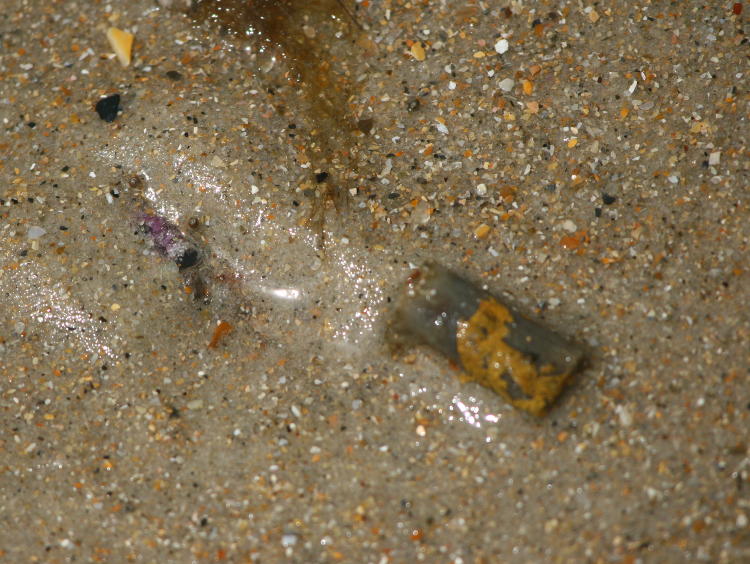
I have to include this pair of images, just for giggles. Walking the waterline along the inlet, which shows tidal fluctuations but no wave action, I was watching for items of interest and noticed a curious patch of slightly disturbed sand alongside a discarded cigarette butt, with a telltale spot of color. But let’s have a closer look.

Here we can see the value of eyestalks, since they’re plainly visible above the sand – as long as you went in very close. I suspect this is a female depositing eggs, since it was buried before we got into the vicinity, and I’m not sure if the cigarette had anything to do with it – the nicotine does sometimes attract critters, but other times it repels them, and I can’t vouch for the vices or virtues of crabs (there’s a sentence fragment that shouldn’t be taken from context.) Without the little purple spot on the back, however, even I would have missed this one. And you know that’s saying something, because I miss nothing.
You dare scoff? Let me show you what I did find.
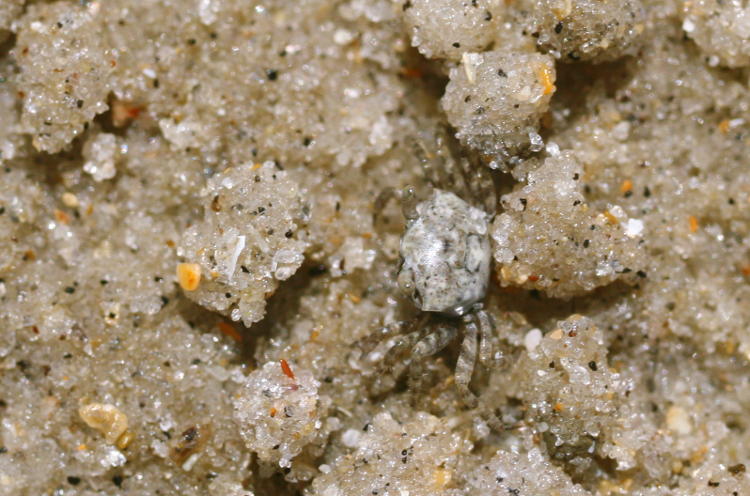
So, scroll back up to that pic of the fiddler hanging from the flip-flop. Get that size in your mind? Now come back down to the animation, and note the pellets of sand they’re surrounded by. Because that’s what this little spud is hiding among, and I’m not even going to try to identify it – I’m fairly certain it’s a juvenile, but that’s about it. A large black ant could have made off with this guy, and capturing it required scooping up the sand it was standing upon because grasping it was next to impossible. I would have had a scale shot in The Girlfriend’s palm but it refused to hold still enough to let me lock focus at such high magnification, so I got it among the sand balls instead. And I’ll be honest, because the color difference from the sand was too subtle to notice at this scale, and I spotted it because it moved instead. Which, really, is the best method that I’ve found of spotting wildlife, and good peripheral vision is a major benefit.
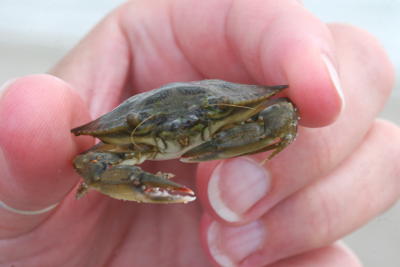 One of the appeals of this portion of the island was the inlet, the only place I found where snorkeling seemed possible, and that was one of our activities while there. The water is shallow and clear, though with an appreciable current except, I suspect, as the tides were transitioning. I only did it for a short while, however, because my eyes are so bad; I need to have an old pair of glasses in the dive mask, and the pair I was using fit terribly and wouldn’t stay in position. Were I back to living in Florida, I would get some disposable contacts solely to use for snorkeling (I don’t really like them otherwise,) but here in NC there are so few opportunities to snorkel that I’d use one, maybe two pairs a year at most – not worth the expense or effort. But during the brief session we found a few items of interest, and I don’t recall who located this juvenile Atlantic blue crab (Callinectes sapidus,) but I’m pretty sure it wasn’t me. Holding it in this manner took a delicate touch, because those points on the carapace were quite sharp, but it was also the only spot to hold it to avoid those chelae – unlike the fiddlers, blue crabs are notoriously aggressive and will pinch for effect.
One of the appeals of this portion of the island was the inlet, the only place I found where snorkeling seemed possible, and that was one of our activities while there. The water is shallow and clear, though with an appreciable current except, I suspect, as the tides were transitioning. I only did it for a short while, however, because my eyes are so bad; I need to have an old pair of glasses in the dive mask, and the pair I was using fit terribly and wouldn’t stay in position. Were I back to living in Florida, I would get some disposable contacts solely to use for snorkeling (I don’t really like them otherwise,) but here in NC there are so few opportunities to snorkel that I’d use one, maybe two pairs a year at most – not worth the expense or effort. But during the brief session we found a few items of interest, and I don’t recall who located this juvenile Atlantic blue crab (Callinectes sapidus,) but I’m pretty sure it wasn’t me. Holding it in this manner took a delicate touch, because those points on the carapace were quite sharp, but it was also the only spot to hold it to avoid those chelae – unlike the fiddlers, blue crabs are notoriously aggressive and will pinch for effect.
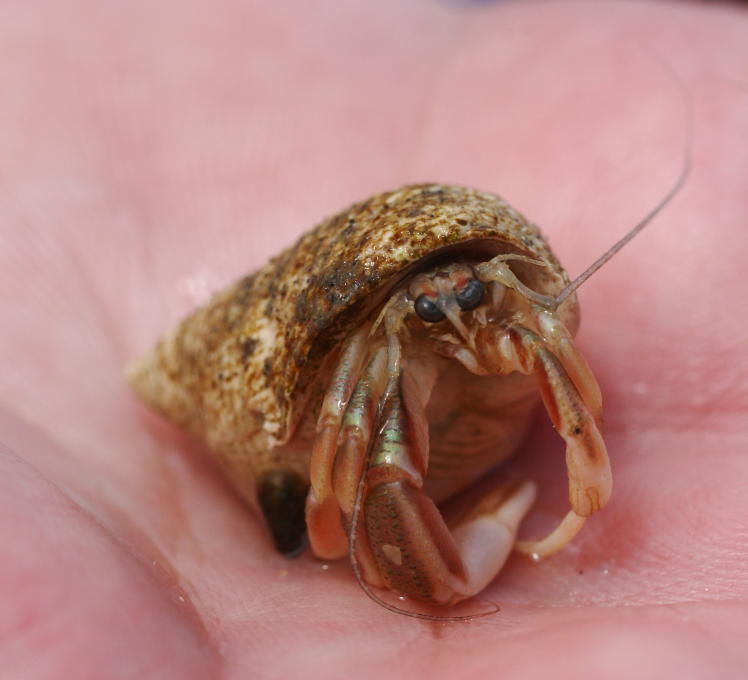
 This one, however, did not. This unidentified hermit crab was remarkably cooperative for its photos, sitting still in The Girlfriend’s palm but fully exposed, and not retracted into its shell as normal (and the whole point of those shells in the first place.) The inlet is a good place to spot hermit crabs, being abundant and generally in clear shallow water; I spotted one large specimen in the sound behind the condo from the dock, but was unable to get to it – the attempt would have required either vaulting from the dock, or crossing a broad boggy area where I would likely have left my sandals (real ones, with proper straps, not silly flip-flops) buried in the muck, as I almost did last year when putting the kayak in.
This one, however, did not. This unidentified hermit crab was remarkably cooperative for its photos, sitting still in The Girlfriend’s palm but fully exposed, and not retracted into its shell as normal (and the whole point of those shells in the first place.) The inlet is a good place to spot hermit crabs, being abundant and generally in clear shallow water; I spotted one large specimen in the sound behind the condo from the dock, but was unable to get to it – the attempt would have required either vaulting from the dock, or crossing a broad boggy area where I would likely have left my sandals (real ones, with proper straps, not silly flip-flops) buried in the muck, as I almost did last year when putting the kayak in.
There are both terrestrial and aquatic hermit crab species, by the way; the terrestrial are the kind sold so often as pets, but the only thing I’ve seen in this region, or even in Florida, are the aquatic varieties, which are capable of being out of the water for a short period of time but require the moisture. Watching for a minute or two may reveal the shell moving across the bottom in shallow water, or just picking up any shell that’s sitting suspiciously with the opening down – empty shells usually sit with the opening upward. On occasion, you get unlucky and only find the original occupants/creators of the shells, by which I mean snails, but I was finding crabs more often than not.
One more crab feature, and then we’re done. For now.
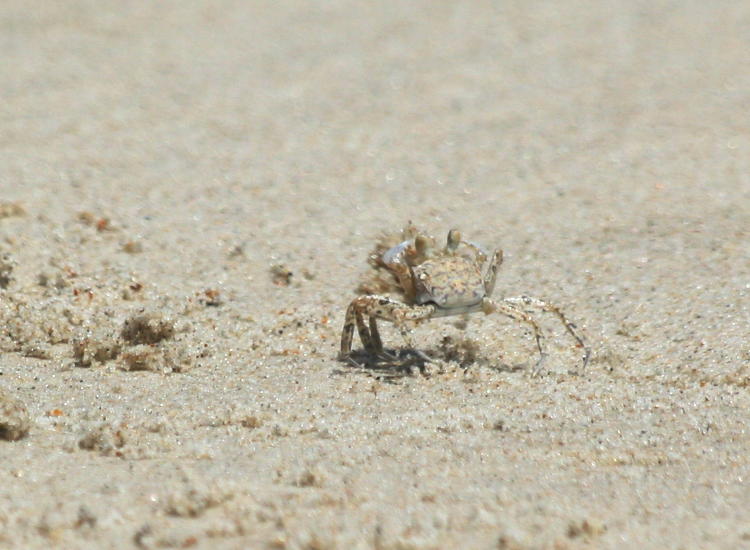
While hanging out at the beach between sessions of boogie-boarding, the others had gone off temporarily in different directions and I was just lounging by myself in the sand when I spotted a small crab cleaning out its warren. Atlantic ghost crabs (Ocypode quadrata) are numerous on the beaches all along the eastern seaboard, but secretive, more active at night or early morning, so watching this one kicking sand from its burrow in early afternoon was a little rare, but not unheard of, and I was mostly seeing it because I wasn’t moving. They might peek out quite often, camouflaged extremely well against the sand, but any kind of movement will send them back into the depths; I became aware of this one, very close to where I sat, because I noticed new deposits around the mouth of the opening. While it was within the burrow, I shifted the boogie-board over to a good location (endeavoring to keep myself clean for once,) propped upon my belly and elbows with camera in hand, and fired off a sequence of shots as it industriously rearranged its living quarters. While I was doing this, two of the others wandered up behind me – I had seen their approach reflected in the LCD panel of the camera but was intent on my subject. Thinking, however, that I was shooting some teenager in a bikini much further down the beach, Mr. Black Ops cleared his throat distinctly (like he can talk) – I’m betting he thought I never noticed.
The sequence, despite being largely handheld and thus not perfectly stable for such things, still lent itself to another animation.
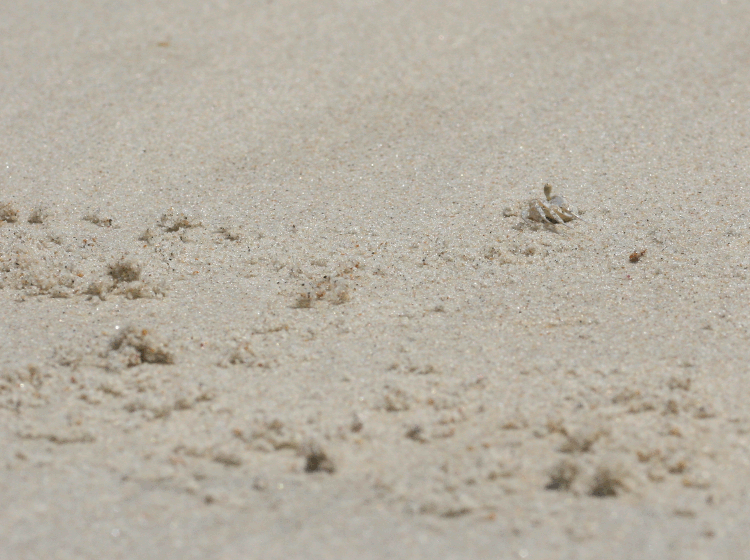
This is just a series of still photos run in sequence, and I wasn’t intending to do this at the time or I wouldn’t have been shifting position and depth between the shots. Also (and I may be stating the obvious,) the period between appearances was a whole lot longer than what you see here – give or take, a minute or two. The funny thing was, the video camcorder was sitting right alongside me, but I’ve never tried it out for macro work, while the video-capable DSLR was back in the condo – like I said, vacation, not necessarily a shooting trip.
But there’s one frame I’m going to highlight, just for the detail.

See the shadow? Yeah, the little ignatz was hurling the sand directly at me in this shot, and I, supreme photographer that I am, caught it in midair (just, you know, not in focus.) Oh, the crab knew I was there, all right…




















































